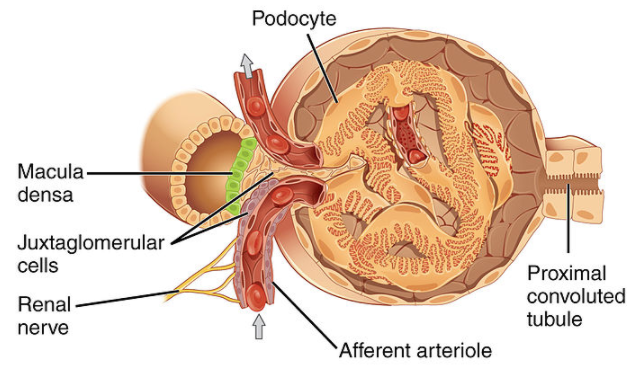
Juxtaglomerular apparatus is made of
a. Juxtaglomerular cell. macula densa and lacis cell
b. Juxtaglomerular cell, lacis cell, and myoepithelial cell
c. Juxtaglomerular cell, lacis cell, and Purkinje cell
d. Juxtaglomerular cell. macula densa and argentaffin cell
Answer
567k+ views
Hint: Juxtaglomerular apparatus is also called as juxtaglomerular complex, and it got this name because it presents next to the glomerulus, and it is one of the structures in each kidney, that regulates the nephron, which is the functional unit of the kidney.
Complete answer:
Structure: Juxtaglomerular apparatus is a part of the nephron, next to the glomerulus and it is present between the afferent arteriole of the nephron and distal convoluted tubule of the same nephron, this juxtaglomerular apparatus is very critical in regulating the renal blood flow and the glomerular filtration rate.

This juxtaglomerular apparatus mainly consists of three types of cells by a name they are given below:
> Macula Densa - This is present in the distal convoluted tubule, these cells increase the glomerular filtration rate by the concept of purinergic signaling.
> Juxtaglomerular cells - These are also called granular cells and these cells secrete renin. These cells are present in the tunica media of the afferent arterioles, this cell stimulates beta-adrenergic receptors, they decrease the renal perfusion pressure, which decreases the NaCl concentration and this all finally decreases glomerular filtration rate.
Other types of cells are Extra glomerular mesangial cells, this is also called Lacis cells, which are present between the afferent and efferent arterioles, they are contractile in nature similar to smooth muscles and they regulate the glomerular filtration rate, by altering the vessel size.
Hence, the correct answer is option (A).
Note: Sometimes there is excessive secretion of renin, which activates the renin-angiotensin system, this results in the increase of more blood volume and causes hypertension, but this hypertension in not effective for normal medications used for hypertension, there should be a change or modification in the lifestyle.
Complete answer:
Structure: Juxtaglomerular apparatus is a part of the nephron, next to the glomerulus and it is present between the afferent arteriole of the nephron and distal convoluted tubule of the same nephron, this juxtaglomerular apparatus is very critical in regulating the renal blood flow and the glomerular filtration rate.

This juxtaglomerular apparatus mainly consists of three types of cells by a name they are given below:
> Macula Densa - This is present in the distal convoluted tubule, these cells increase the glomerular filtration rate by the concept of purinergic signaling.
> Juxtaglomerular cells - These are also called granular cells and these cells secrete renin. These cells are present in the tunica media of the afferent arterioles, this cell stimulates beta-adrenergic receptors, they decrease the renal perfusion pressure, which decreases the NaCl concentration and this all finally decreases glomerular filtration rate.
Other types of cells are Extra glomerular mesangial cells, this is also called Lacis cells, which are present between the afferent and efferent arterioles, they are contractile in nature similar to smooth muscles and they regulate the glomerular filtration rate, by altering the vessel size.
Hence, the correct answer is option (A).
Note: Sometimes there is excessive secretion of renin, which activates the renin-angiotensin system, this results in the increase of more blood volume and causes hypertension, but this hypertension in not effective for normal medications used for hypertension, there should be a change or modification in the lifestyle.
Recently Updated Pages
Master Class 12 Business Studies: Engaging Questions & Answers for Success

Master Class 12 Economics: Engaging Questions & Answers for Success

Master Class 12 English: Engaging Questions & Answers for Success

Master Class 12 Maths: Engaging Questions & Answers for Success

Master Class 12 Social Science: Engaging Questions & Answers for Success

Master Class 12 Chemistry: Engaging Questions & Answers for Success

Trending doubts
What is meant by exothermic and endothermic reactions class 11 chemistry CBSE

Which animal has three hearts class 11 biology CBSE

10 examples of friction in our daily life

One Metric ton is equal to kg A 10000 B 1000 C 100 class 11 physics CBSE

1 Quintal is equal to a 110 kg b 10 kg c 100kg d 1000 class 11 physics CBSE

Difference Between Prokaryotic Cells and Eukaryotic Cells




